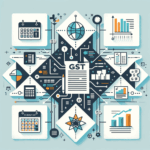Understanding GST Invoicing and Its Impact on Return Filings
As a business owner in India, you know that filing GST returns is a critical monthly task. But the accuracy of your entire return hinges on one foundational document: the GST invoice. This document is far more than just a bill for your customers; it’s a legal record that forms the very basis of the entire GST compliance ecosystem. Understanding the profound GST invoicing impact on return filings is non-negotiable for seamless tax compliance and healthy cash flow. This guide will break down the crucial connection between your invoices and your returns, exploring how one directly influences the other. We will help you avoid common pitfalls and ensure your business stays on the right side of the law. This guide is specifically designed for small business owners and entrepreneurs looking for a clear GST invoicing guide for businesses in India.
What is a GST Invoice? The Fundamentals Explained
A GST invoice is an official document issued by a supplier of goods or services to the recipient. It serves as evidence of a transaction and is essential for both the supplier to report their tax liability and the recipient to claim Input Tax Credit (ITC). The government’s Goods and Services Tax Network (GSTN) is built on a system of invoice matching, where the details of an invoice issued by a seller must match the details claimed by the buyer. Therefore, getting the invoice right from the start is the first and most important step in GST compliance. A correctly prepared invoice ensures transparency, prevents tax evasion, and creates a seamless flow of credit through the supply chain, which is fundamental for understanding GST invoicing India.
Key Components of a Valid GST Invoice
For an invoice to be considered valid under GST law, it must contain specific mandatory fields. Omitting any of these details can render the invoice invalid, potentially leading to the denial of Input Tax Credit for your customer and compliance issues for you. It’s crucial to ensure every invoice you issue is complete and accurate.
Here are the essential components of a GST-compliant invoice:
- Supplier’s Information: Full Name, Address, and Goods and Services Tax Identification Number (GSTIN).
- Invoice Number: A unique serial number for the financial year, which must be consecutive and not exceed 16 characters.
- Date of Issue: The date the invoice is created.
- Recipient’s Information: Full Name, Address, and GSTIN (if they are a registered taxpayer).
- HSN/SAC Codes: Harmonized System of Nomenclature (HSN) for goods or Service Accounting Code (SAC) for services.
- Description of Goods/Services: A clear description of what is being supplied.
- Quantity and Unit: The quantity of goods (e.g., kgs, pcs, litres) and the unit of measurement.
- Taxable Value: The value of the supply after deducting any discounts.
- Tax Breakdown: The applicable rates and amounts for Central GST (CGST), State GST (SGST), Integrated GST (IGST), and any applicable Cess.
- Place of Supply: The state or union territory where the supply is considered to have taken place, which determines whether CGST/SGST or IGST is applicable.
- Signature: A physical or digital signature of the supplier or their authorized representative.
Common Types of Invoices under GST
Not all transactions require the same type of invoice. GST law specifies different documents for different scenarios. Using the correct type of document is essential for accurate reporting.
- Tax Invoice: This is the most common type of invoice. It is issued by a GST-registered business for the sale of taxable goods or services. (For new entrepreneurs, our Ultimate Guide to GST Registration for Small Businesses explains the initial setup process). It must contain all the mandatory components listed above, including the tax breakdown. The recipient uses this document to claim Input Tax Credit (ITC) on their purchase.
- Bill of Supply: This document is issued in two specific cases: when a registered business supplies exempt goods or services, or when a business registered under the Composition Scheme makes a supply. Since no tax is collected on these supplies, a Bill of Supply is issued instead of a Tax Invoice, and the buyer cannot claim any ITC. For readers interested in this option, Understanding the Composition Scheme Under GST provides a complete overview.
- Debit and Credit Notes: These are supplementary documents used to modify an original tax invoice. A Debit Note is issued when the taxable value or tax charged in the original invoice needs to be increased (e.g., due to a price revision). A Credit Note is issued when the value needs to be decreased (e.g., due to goods returned by the customer or a post-sale discount). These notes must be linked to the original invoice number.
The Direct Link: How Invoices Dictate Your GST Returns
The entire GST compliance framework is designed around the digital trail created by invoices. The GSTN, the technology backbone of GST, works by matching the sales data uploaded by the seller with the purchase data of the buyer. This intricate system of cross-verification ensures that tax credits are claimed only on genuine transactions where tax has been duly paid to the government. This is the core of the GST invoicing effect on returns, turning every single invoice into a data point that directly feeds into the monthly and quarterly returns filed by businesses across the country. Understanding this flow is essential for appreciating why invoice accuracy is paramount.
Outward Supplies: Invoices and Your GSTR-1 Filing
Your GSTR-1 is the return where you declare all your outward supplies, or sales, for a specific tax period. Essentially, this return is a detailed summary of every single tax invoice, debit note, and credit note you have issued to your customers. When you prepare your GSTR-1, you are required to upload invoice-wise details for all B2B (business-to-business) transactions, including the recipient’s GSTIN, invoice number, date, value, and tax amounts. For B2C (business-to-consumer) transactions, consolidated summaries are usually sufficient.
Key Takeaway: Your GSTR-1 is not just a summary; it is a direct reflection of your sales invoices. Any error on an invoice, such as a wrong GSTIN or an incorrect tax calculation, gets carried directly into your GSTR-1, triggering a chain reaction of compliance issues.
Inward Supplies & ITC: The Role of GSTR-2A and GSTR-2B
Once you file your GSTR-1, the B2B invoice details you’ve uploaded are automatically reflected in the GSTR-2A and GSTR-2B of your respective customers. GSTR-2A is a dynamic, real-time statement of all inward supplies, while GSTR-2B is a static, auto-drafted statement that is generated once a month. For the purpose of claiming Input Tax Credit, GSTR-2B is the critical document. It provides a summary of the eligible and ineligible ITC for that tax period based on the GSTR-1 filed by your suppliers.
Key Takeaway: You can only claim ITC on purchases that your supplier has correctly reported in their GSTR-1 and which subsequently appear in your GSTR-2B. This is the most direct example of the invoice impact on return filing in India. If your supplier makes a mistake on their invoice or fails to file their return on time, your ability to claim ITC is directly and negatively affected, impacting your cash flow.
The Final Step: Filing GSTR-3B
The process culminates with the filing of GSTR-3B, which is a monthly summary return. In this form, you declare your total tax liabilities (derived from the sales data in your GSTR-1) and claim the eligible Input Tax Credit (as reflected in your GSTR-2B). You then pay the net tax liability (Total Tax Payable – Eligible ITC) to the government. The system is designed to connect all these dots seamlessly. A correctly reported sales invoice populates GSTR-1, which in turn populates the buyer’s GSTR-2B, which finally determines the ITC figure for the buyer’s GSTR-3B. This interconnected process provides a comprehensive GST return filings overview, showing how every step relies on the accuracy of the initial invoice. Our comprehensive article, ‘How to File GST Returns Online: A Step-by-Step Guide of the GST Filing Process & Procedure,’ covers this entire workflow in detail.
Common Mistakes and the GST Invoicing Impact on Return Filings
Even minor errors in invoicing can cascade into significant compliance problems, leading to tax notices, penalties, and disputes. Understanding these common pitfalls is the first step toward avoiding them and ensuring a smooth return filing process. The GST invoicing impact on return filings is most acutely felt when these mistakes occur, disrupting business operations and creating unnecessary financial strain. A diligent approach to invoicing can save you from considerable trouble down the line.
Mismatch Errors: Incorrect GSTIN or HSN Codes
The Problem: One of the most frequent errors is entering an incorrect customer GSTIN or HSN/SAC code on an invoice. A single wrong digit in a 15-digit GSTIN can lead to the invoice being attributed to the wrong taxpayer or being rejected by the system altogether. Similarly, using an incorrect HSN code can result in applying the wrong tax rate (e.g., charging 12% instead of 18%).
The Impact: When you enter the wrong customer GSTIN, the invoice will not appear in their GSTR-2B. This means your customer cannot claim their rightful Input Tax Credit, which will inevitably lead to payment disputes, follow-ups, and a potential loss of trust and business. An incorrect HSN code can attract scrutiny from tax authorities during audits, leading to demands for the differential tax, along with interest and penalties.
Data Discrepancy Between GSTR-1 and GSTR-3B
The Problem: This is a major red flag for the GST department. It occurs when the total tax liability you declare in your summary return (GSTR-3B) does not match the liability calculated from the detailed invoices you reported in your GSTR-1 for the same period. This discrepancy can happen due to last-minute manual adjustments, data entry errors, or a failure to properly reconcile accounts before filing.
The Impact: The GSTN system is programmed to automatically detect such mismatches. A discrepancy between GSTR-1 and GSTR-3B will almost certainly trigger an automated notice (like Form DRC-01B) from the tax department, demanding an explanation or payment of the differential tax amount. Ignoring these notices can lead to further penalties and recovery proceedings.
Delayed or Missed Invoice Reporting
The Problem: Failing to report an invoice in the GSTR-1 of the correct tax period is another common mistake. This could be due to oversight, delayed bookkeeping, or simply forgetting to include a particular transaction.
The Impact on Seller: If you delay reporting an invoice, you are also delaying the payment of tax on that supply to the government. This makes you liable to pay interest on the tax amount for the period of the delay, calculated from the original due date of the return.
The Impact on Buyer: For the buyer, the consequences are more immediate. If your invoice is not reported in your supplier’s GSTR-1 for a particular month, it will not appear in your GSTR-2B for that month. This means you lose the ability to claim ITC for that period, which directly hurts your working capital by forcing you to pay the entire tax liability in cash.
Best Practices: A GST Invoicing Guide for Businesses
Staying compliant and avoiding the negative consequences of invoicing errors requires a proactive and systematic approach. By implementing a few key practices, you can streamline your processes, minimize risks, and ensure your return filings are always accurate and timely. This practical GST invoicing guide for businesses focuses on creating robust systems that protect your business from common pitfalls.
Automate with Accounting Software
Actionable Tip: Manual invoicing and bookkeeping are prone to human error. Investing in a reliable accounting or invoicing software is one of the best decisions a small business can make. These tools are designed to be GST-compliant and can automate many critical tasks. They can validate GSTINs, auto-populate customer details, apply the correct tax rates based on HSN codes, generate professional invoices in the right format, and directly prepare data for your GSTR-1 filing. This significantly reduces the risk of manual errors and saves a tremendous amount of time.
Implement a Verification Process
Actionable Tip: Before you click the “submit” button on your GSTR-1, implement a simple two-step verification process. First, ensure that the total sales figure in your accounting software for the month matches the total taxable value being reported in your GSTR-1. Second, randomly select a sample of 5-10 B2B invoices from your GSTR-1 data and cross-check them against the actual invoices in your records. This quick audit can help you catch critical errors like incorrect invoice numbers, dates, or GSTINs before they become a problem for your customers.
Reconcile GSTR-2B with Purchase Records Religiously
Actionable Tip: This is arguably the most crucial step for managing your Input Tax Credit effectively. Before you file your GSTR-3B each month, make it a non-negotiable habit to download your GSTR-2B from the official GST Portal. Meticulously compare this statement with your own purchase register or accounting records. This reconciliation will help you identify any invoices for which your suppliers have not yet filed their returns. You can then proactively follow up with those suppliers to ensure they upload the missing invoices, allowing you to claim your full, eligible ITC and optimize your cash flow.
Conclusion
Proper GST invoicing is not just a bookkeeping formality; it is the absolute foundation of accurate GST compliance in India. From correctly calculating your monthly tax liability in GSTR-1 to legitimately claiming Input Tax Credit based on your GSTR-2B, every critical step in the return filing process is directly tied to the data on your invoices. A small error at the invoicing stage can create significant ripples, leading to compliance notices, financial penalties, and strained relationships with your customers.
By embracing best practices like automation, verification, and regular reconciliation, you can mitigate these risks effectively. A clear understanding of the GST invoicing impact on return filings empowers your business to stay compliant, manage working capital efficiently, and avoid the stress of unnecessary tax notices. It transforms a mandatory compliance task into a strategic business process that strengthens your financial health.
Navigating GST compliance can be complex. If you need help streamlining your invoicing and return filing process, TaxRobo’s team of experts is here to assist. Contact us today for a hassle-free GST experience!
Frequently Asked Questions (FAQs)
1. What should I do if I make a mistake on an already issued GST invoice?
Answer: You cannot revise an invoice that has already been uploaded to the GST Portal. The correct procedure is to issue a supplementary document. If you need to increase the taxable value or tax amount, you must issue a Debit Note. If you need to decrease the value or tax (e.g., for a sales return), you must issue a Credit Note. These notes must be reported in the GSTR-1 of the month in which they are issued.
2. Is e-invoicing mandatory for my small business?
Answer: E-invoicing, where invoices are electronically authenticated by the Invoice Registration Portal (IRP), is mandatory for businesses with an annual aggregate turnover exceeding a certain threshold. This threshold has been progressively lowered over time. As of the latest updates, it applies to businesses with a turnover exceeding ₹5 crore. It is crucial to check the official GST portal for the current, applicable turnover limit, as these rules are subject to change.
3. Can I claim ITC if my supplier’s invoice is not showing in my GSTR-2B?
Answer: As per current GST rules, claiming Input Tax Credit is strictly linked to the details appearing in your GSTR-2B. If a valid invoice from your supplier is missing from this statement, you should not claim the ITC on it in your GSTR-3B. Instead, you must immediately contact your supplier and request them to report the invoice in their GSTR-1. Claiming ITC on missing invoices is a compliance violation and can lead to the reversal of the credit along with interest and penalties.
4. How long must I preserve my GST invoices and related records?
Answer: Under GST law, you are legally required to maintain all your business records, including invoices, bills of supply, credit/debit notes, books of account, and filed returns, for a minimum period of 72 months (6 years). This period is calculated from the due date of filing the Annual Return for the financial year to which the records pertain.



